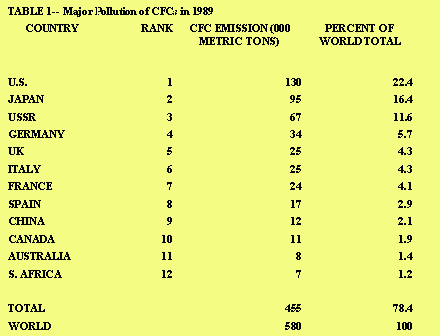Stratospheric Ozone Layer
Depletion
Previous Page
Page 10
Banning
CFCs
As
little as one year after Rowland and Molina announced their theory publicly, government
agencies and private corporations began responding. Johnson Wax, America's
fifth largest producer of aerosol spray can, announced that they would stop
production. At that same time, Oregon bans the use of CFC containing aerosols.
Soon the United States government follows suit and by October of 1978, aerosol
spray cans were banned in the United States. Unfortunately, most other
consumers and the largest producer of CFCs, Du Pont, refused to admit there was
a problem. Slowly, more and more evidence is found to support the Rowland and
Molna theory. By 1987, the United States government has decided that stricter
regulations are needed in many areas. Other manufacturers have voluntarily
agreed to phase out CFCs ahead of EPA mandated phase-out schedules. Almost
fifteen years after Rowland and Molina first suspected that CFCs could cause
the depletion of the stratospheric ozone layer, the world community of
scientists and policy-makers wee about to come together to formulate a
comprehensive policy to do something about the problem.
The
Montreal Protocol
If scientists can
separate the human and natural causes of ozone depletion, they can formulate
improved models for predicting ozone levels. The predictions of early models
have already been used by policy makers to determine what can be done to reduce
the ozone depletion caused by humans. For example, faced with the strong
possibility that CFCs could cause serious damage to the ozone layer, policy
makers from around the world signed a treaty known as the Montreal Protocol in
1987. The signatory countries agreed to reduce production of CFCs by 50% from
the 1986 baseline values by 1996. In order to achieve this goal, the protocol
set out different phase-out schedules for allowable and accelerated phase-outs.
These two plans were at opposite ends of the spectrum. Accelerated refers to
the fastest possible removal while allowable is the removal at the last
possible moment.
The
protocol also made some concessions to less developed countries (LDCs). These
concessions included a ten year grace period before compliance was required as
well as a recommendation to the more developed countries to help pay for the
transition to CFC alternatives. Even though there was scientific consensus
concerning the harmful nature of CFCs, the economic benefits provided by using
the chemical provided a formidable problem that needed to be overcome. LDCs
could not or would not forgo their use without some attractive economic
incentives. This interplay between the facts that science promotes and the
economics that drives society is the balancing act that policy-makers must try
to control. Though the original protocol was not perfect, it was a good attempt
at trying to balance international environmental concerns about the depletion
of the ozone layer and the economic concerns of many of the LDCs who would have
to comply with its cuts.
The
initial countries to ratify the protocol included: Canada, Denmark, Egypt,
Finland, France, West Germany, Ireland, Italy, Japan, Malta, Mexico, The
Netherlands, New Zealand, Norway, Spain, Sweden, The United Kingdom, The United
States and The USSR. The protocol went into effect on January 1, 1989 after
these countries ratified it. Table 1 shows the major emitters of CFCs at that
time.

This table shows the unbalanced contribution to the problems by
members of the world community. The top twelve emitters contribute 78.4% of the
world total of CFCs. Worse than that, the top three emitters--the U.S., Japan,
and the USSR--contributed a combined 292,000 metric tons of the world's total
of 580,000 metric tons of CFC pollution. These three nations emit 50.4% of the
CFCs in the world's atmosphere. Facts such as these, coupled with continuing
pressure from world governments and nongovernmental organizations, allowed
amendments to the original Montreal Protocol to be developed.
Though
the 1987 Montreal Protocol was a good beginning, more evidence of rapidly
increasing ozone depletion over both poles led to a rising tide of concern and
a movement for accelerated phase-out of CFCs. In 1990, the London Amendments
were passed. The signatory countries for these new amendments agreed to a total
ban of CFCs by the original 1996 date. Also, they established a relief fund for
LDCs that would be adversely affected by the new agreement. The original
protocol did not attract China or India--two major potential users. After the
amendments, however, these and many other countries participated in the ban
with the understanding that the fund of $260 million dollars would be used to
offset their costs. Two year later, the Copenhagen Amendments increased the
fund to over $500 million and accelerated the compliance schedule. These
adjustments have made the Montreal Protocol an effective international
agreement that has succeeded in gathering support from the nations of the
world.